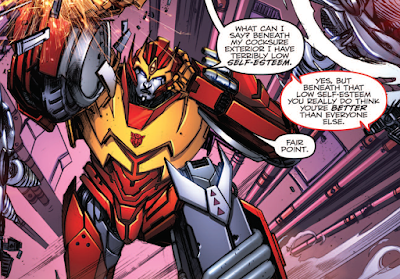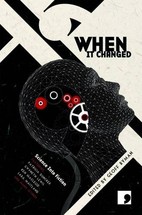If you read my commentary (I hesitate to call it a "review") on
the third series of Primeval, you'll know I wasn't exactly enthused. But we already owned series 4 and 5 on DVD, so onward we plunged-- hey, at least they'd killed off the villain who rapidly decayed from interesting and enigmatic to maniacal and annoying.
At the end of the first episode of series 4, I turned to my wife and was like, "Actually, that was pretty good." Then at the end of the second episode, I did it again. And then again in the third! I don't know what exactly happened-- production moved to Ireland to save costs, but as far as I can tell, the head writer stayed the same, as did most of the freelance writers and directors. Yet with series 4 came a higher level of seriousness and more of a focus on character that had been lacking from the show, as well as a feeling of reality. It's hard to explain, but the show became suddenly, noticeably
better. And not just better than it was in the bizarre series 3, but better than it had ever been. (I know some people out there aren't big series 4/5 fans, but I find that perspective unfathomable.)
 |
On the other hand, the webisodes have this
whole thing about how they aren't going to
wear black uniforms in the field anymore...
and they still do. |
The increase of quality was evident even before we began watching series 4 proper-- to bridge the gap between series 3 and 4 (which was eighteen months), there was a series of five "webisodes," each about five minutes long, covering a lot of the changes, as two of series 3's main cast didn't return, and two more team members were got rid of. In my commentary on series 3, I complained that Captain Becker, the Sexy Man of Action character, was so devoid of personality that the writers couldn't even land a joke about how devoid of personality he was... and then in one thirty-second scene in a single webisode he displayed more personality than in all ten episodes of series 3 put together!
The main cast is definitely one of the most prominent areas of improvement, and given that the plots on
Primeval were never exactly things of genius, this is a pretty essential area. The two worst characters from series 3 don't come back-- team leader Danny Quinn and historian Sarah Page. Danny was lost in time at the end of series 3, and series 4 keeps him out of the way by reiterating that, but series 4 actually kills Sarah off with a quick line about a mission gone wrong! I didn't particularly love her character, but whoa, harsh!
 |
Cutest moment of series 4: how worried Lester is for these
two. |
Connor and Abby were stranded in time at the end of series 3, but series 4 begins with them making it back to the present day and they rejoin the team in short order. I was a little skeptical about them being in a romance at first (during the will-they-won't-they stuff of earlier seasons, I kind of felt like I liked them better as goofy friends), but series 4 and 5 do a good job with the romance, portraying them as both good friends and real lovers, but still finding room for genuine character conflict. Mind you, Connor's ascent into nerd-genius-dom is completed: an undergraduate biology major in series 1, whose main skill was having a really nice historical database, he's now a physics supergenius whose skills are sought by the head of a major tech corporation. There
is a really good episode about one of Connor's undergrad buddies from series 1, who's descending into being a conspiracy theory nut in his absence-- it was one of the surprisingly good ones.
Lester annoyed me in the first series, but each series has found a way to make him a little bit better than in the previous-- 4 and 5 get the mix of humour, affection, and pompousness just right for Britain's best bureaucrat.

There's a really good moment in one episode that shows how the writing of series 4 is much more character-based: with one team member stranded in the past, there's a debate about whether to go through the anomaly to rescue him or to lock the anomaly to reduce the danger. Becker thinks a rescue can't be risked-- thinking about the death of Sarah on a similar mission. Abby, fresh from a year-long exile to the past, thinks every chance has to be given for a rescue. Each has their own, perfectly reasonable perspective. It's not a big thing, but it's more sophisticated than previous seasons gave us.
That said, the new characters are great. A new team function is added with Jess, who stays back at the base and co-ordinates while everyone else is out in the field. As a result, she (usually) doesn't play a big role in missions, but she was a fun character. (Weirdly, there's a subplot set up about her, Abby, and Connor all living in the same apartment which never comes up again. As this would be the third Connor-rooms-with-another-team-member subplot in four seasons, maybe this would be for the best.)
 |
| First team leader on this show I'd actually trust with my life. |
The new team leader is Matt Anderson, who I am relieved to say is not a cop who doesn't play by the rules. He's a refugee from an apocalyptic future who came back in time undercover to prevent that future, but even though that plotline is pretty well done, what impresses about Matt is that he's just a
really good leader, much moreso than Cutter or Danny ever were. There's one episode where the team accidentally takes a submarine into prehistory(!), and Matt doesn't really do anything flashy, he just calmly works with the other characters to organize them, keep them on task, and give them the confidence and space to do their jobs. That nice, subtle writing did a lot to warm me up to Matt. Plus, Ciarán McMenamin is just very likeable. He doesn't seem to have done a lot post-
Primeval, which is a shame.
(Danny does make a one-episode return. This didn't exactly fill me with cheer, but it does tie off an old dropped plot, and the writers purposefully/deliberately foreground his ridiculousness, as he immediately begins fighting prehistoric creatures with a giant stick named "Molly"! Jenny also returns for one episode, which was a lot more welcome.)
 |
| Oh my, Julian! |
The other new main cast member is Alexander Siddig of
Star Trek: Deep Space Nine fame as Philip Burton. Honestly, he feels a little wasted-- it could have been an interesting role, but the character is written pretty flatly, and his agenda is a bit too obvious. Still, I think Siddig's salt-and-pepper look here is probably peak sexiness for him. Ruth Bradley, who played the eighth Doctor's companion Molly O'Sullivan in the
Dark Eyes audio dramas also has a recurring role as Lady Emily, a Victorian adventuress, though I felt like they never quite delivered on her potential. (And there's one subplot with her that's just left forgotten.)
If you'd asked me at the end of series 3, I might've suggested on giving up on it all-- or only watching it to delight in the bad television of it all. But I persevered, and series 4 and 5 turned out to be a pretty solid team-based adventure show. If only they'd kept this set-up going! But other than a short-lived Canadian spin-off, that was it for
Primeval.
(Series 5 needed more Rex, though.)





































